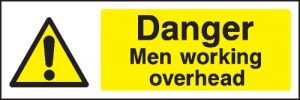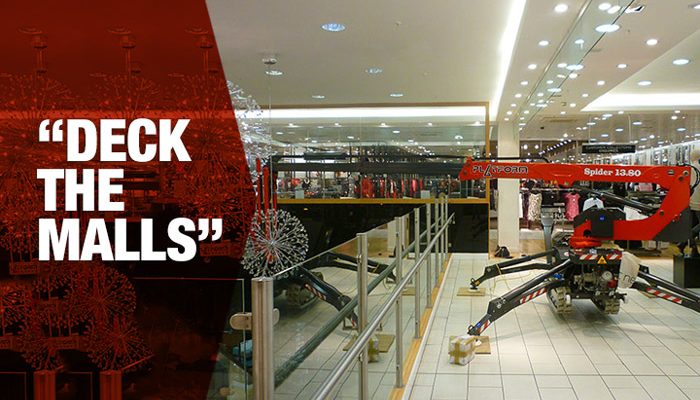
MEWPS Indoors – Deck the Malls
26 November 2017
MEWPS Indoors and the run-up to Christmas
It’s that time of year again! The festive season has arrived amidst a festoon of decorations hanging in all the shops. Wander through the malls and you can’t help but be impressed with the magnificence of the hanging decorations. Suspended as if by magic they are of course the result of careful planning and specialist working at height equipment. Operating MEWPS indoors poses a number of challenges for the teams involved.
General MEWPS Indoors
Operating MEWPS indoors can add to the usual safety concerns for the workforce. It can be complicated to get the MEWPS indoors to the work area, let alone set it up and start using it. MEWPS often need to be transported through a tight space and set up, taking care not to damage the surrounding environment and making sure the machine is fully operational and safe despite these additional limitations.
Our MEWPS Indoors
Our MEWPS have been specially designed to work indoors. They provide maximum functionality both indoors, and in tight spaces. Sometimes referred to as spider lifts, the name comes from the shape of the stabilizer legs. These legs fold up to enable the lift to be used in narrow spaces. They will pass through standard width doorways or gateways which would be problematic for other types of lift. This clever design does not mean a compromise on the overall functionality of the lift as they are still able to safely reach significant heights, and have strength and stability on the Mall floors.
Indoor MEWP Functions
They have a number of features which make them particularly useful for jobs indoors or in more delicate areas.
These include:
• A tracked chassis to spread the weight of the lift over a larger area and reduce the ground bearing pressure, preventing damage to fragile floors or pathways.
• Electric motor power option for indoor use which reduces operational noise with no exhaust fumes.
• Lower overall weight than other types of lift but with no reduced functionality.
• Easy to transport as most are road towable.
• Radio control options for use in tight space.
Due to their narrow design and low ground pressure make our MEWPS flexible and reliable on delicate surfaces. The spider-like legs can even be set up in different positions on different ground levels (for example steps or platforms). This means our MEWPS can be used in compact spaces where other lifts are unable to work.
Summary
MEWPS are the least disruptive type of powered access platform. They are not only flexible, but also adaptable for a range of unique and specific jobs. They have reduced noise, flexible access and can be used on most surfaces without compromising safety or functionality. MEWPS do not cause damage to more delicate surfaces, even in the most unusual spaces.
So the next time you are riding up the escalator admiring the decorations, spare a thought for the wonder of the MEWP that allowed it all to happen and tell the kids the Christmas fairies did it all 🙂
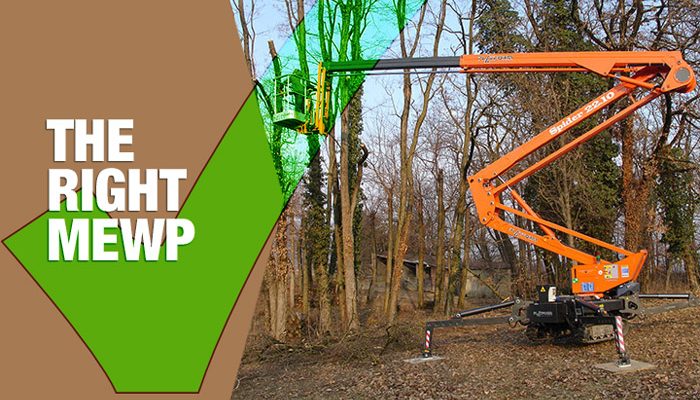
Choosing a MEWP For The Job
19 November 2017
Questions to ask.
Choosing a MEWP for a specific job can make a difference to the time it takes to do and how much it costs to get the job done.
Different models have alternative features that can suit very specific tasks at height and in a wide range of locations and circumstances. As with any job, it is essential to get the right equipment and the right people.
When you are choosing a MEWP there are some questions you need to ask to help you choose the right equipment for your specific business needs.
Location
• How far will people and equipment need to be transported?
• What is the height distance that needs to be reached?
• How many people will it take to complete the job?
• Is the job on or off site and how does this impact on the work?
• Are there multiple tasks that could require a vehicle mounted access platform?
Space and access
• Is the job indoors or outdoors?
• Is it a tight space that could require a spider lift?
• Is there sufficient room to reach the site, set up and safely install and remove the access equipment?
• Are there any obstructions such as branches or architectural overhangs which may need the flexibility of a boom lift?
Ground conditions
• Can the ground take the weight of the powered access platform?
• Are there any steep slopes or poor ground conditions?
• Are there any fragile surfaces that could require extra stability?
• Can the site be accessed by road or will it require an all-terrain powered access platform?
Frequency of use
• Do you have on-going jobs at height or is it a one off requirement?
• Is it more cost effective to buy rather than rent equipment?
• Do you have adequate storage space for an access platform?
Health and Safety
• Are staff trained to operate a powered access platform safely and effectively?
• Has a risk assessment been carried out on site?
• Does the job require heavy lifting?
Summary
Powered access equipment is a the safest option for working at height, especially if the job involves reaching awkward spaces, lifting heavy tools or equipment, accessing jobs in hard to reach areas or on unstable ground and fragile surfaces.
Different equipment can solve a range of specific problems including working indoors or in tight spaces (spider lifts); reaching jobs in remote areas (all-terrain vehicles); and carrying out multiple jobs on site in one go (mobile work platforms).
Each individual job and industry will have specific requirements for access equipment but asking the right questions are a good starting point to ensure you get the best powered access solution.
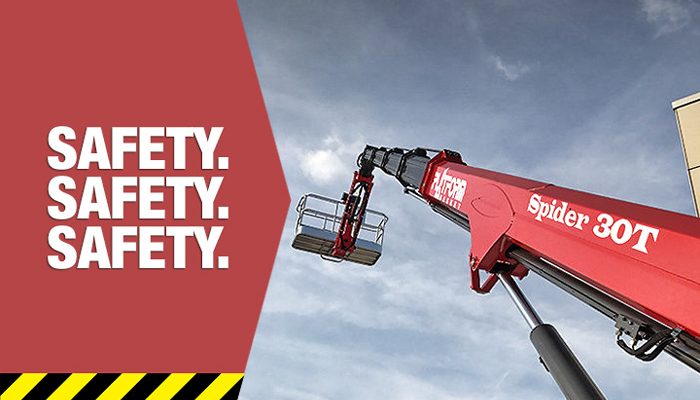
MEWPs – Safety at Height
12 November 2017
Every Day Before You Start
Think Safety At Height!
Thankfully accidents involving MEWPs have been declining over the last ten years. HSE legislation and IPAF awareness programmes have played an important role but on the front line it is the users of access power equipment who are pivotal in ensuring safety at height and reducing accidents.
For the safe performance of your powered access platform, is vital to ensure the equipment is in the optimum condition before every use. Maintaining and servicing access equipment will prolong its life and is required to meet health and safety regulations.
A pre-start inspection should be carried out every day and all staff should be briefed in what they entail. These checks will confirm that the machinery is safe to operate and identify any potential hazards it may pose before the work at height is carried out.
What to check
There are a number of key functions and features on access platforms which should be in full working order before the equipment is used. Even if the access equipment is rented from a reputable firm, the hirer is responsible for the health and safety of the people using it, so it is important to carry out your own checks as well as those done by the supplier.
Controls
– Test all lift controls before any people or equipment are raised from the ground. This should include cut out switches and emergency stop mechanisms.
Hydraulic fluid and petrol
– The oil level in the tank should be full when the platform is on a level surface and there should be enough fuel in the tank to complete the job.
Maintenance
– Check the vehicle for any signs of damage or age which might cause it to malfunction. This should include identifying damaged or loose hoses or fittings, rust, corrosion, holes and electrical faults.
Stability
– For a mobile access platform, the brakes of the vehicle should be fully functional. The base of a powered access platform needs to be locked into position before the platform is extended or elevated. Check all stabiliser legs and extendable parts are operational before use.
The Vital Safety At Height Risk Assessment
Before you set up a full risk assessment should be carried out at the site of any job to identify any potential hazards such as overhead power lines or underground services, and to check the ground conditions.
As a minimum you should…
• Make sure the ground is strong enough to take the weight of the equipment before you start to lift anyone or anything.
• Clearly mark off your work area to ensure you have a safe area to complete the job.
• Only allow trained operatives to control the access equipment.
• Make sure the powered access platform is fully stabilized before operation.
• Do not exceed the maximum load capacity of the access platform.
Summary
Carrying out the relevant checks before you start will ensure safety at height. It is worth checking the equipment thoroughly yourself as part of the overall risk assessment of your job. Not only will this ensure that your equipment is well maintained and fit for purpose for longer but it will also prevent avoidable accidents.
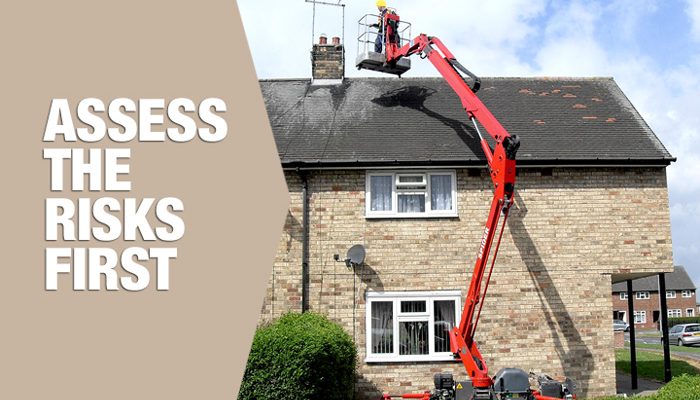
MEWP Risk Assessment
5 November 2017
MEWP Risk Assessment – Don’t start work without it!
Whether you are onsite or offsite, working at height requires a suitable MEWP Risk Assessment to avoid potential dangers.
In the construction industry, work at height is the main cause of fatal and serious injury in the construction industry. Worryingly, most accidents occur on smaller projects. Using powered access platforms does make carrying out jobs at height safer and faster but there are still potential risks and it is important to make sure all staff are aware of any precautions to take.
Health and Safety Executive (HSE) statistics show more than 60% of deaths resulting from work at height involve falls from ladders, scaffolds, working platforms and roof edges; or falling through fragile roofs. Although this has been a downward trend for the past 10 years, the financial cost has been significant along with the human cost to families and friends.
MEWP Risk Assessment – Accident prevention
To continue the downward trend of work at height accidents, the law requires employers and self-employed contractors to carry out an adequate MEWP risk assessment of the potential risks on each job so they can do everything ‘reasonably practicable’ to protect people from harm.
Carrying out a MEWP Risk Assessment does not need to be overly complicated but it does need to be an important part of planning and completing a job. Both the supervisors and the staff should be aware of the potential dangers so they can actively avoid them.
The HSE website provides full and detailed advice on planning and completing a risk assessment for a wide range of jobs but here are the five main points to consider:
The five Main Points
• Identify the Hazards – Walk round the site and make observations. Some of these may be obvious but it is worth getting a second opinion in case there is something you haven’t noticed.
• Decide who might be harmed and how – It may be a job onsite or there may be safety concerns for the general public. Make sure staff are adequately trained to complete the work and briefed on the requirements of the job.
• Evaluate the risks and decide on precautions – Avoid working at height where it is reasonably practicable to do so, for example can you get equipment or materials prepped at ground level?
• Record your findings and implement them – Check the maintenance of the powered access platform and other equipment and make sure that workers know how to operate it safely and effectively. Take extra steps to prevent any person falling a distance that could cause personal injury and use equipment to minimise the distance and consequences of a fall if necessary, such as safety nets.
• Review your assessment and update if necessary – circumstances change all the time so your assessment of the risks will too.
Summary
Powered access platforms make working at height safer and quicker but they do not remove all the potential risks such as dangerous structures, bad weather or accidents. A risk assessment will ensure that potential problems are managed and can be prevented, so each job is completed without an incident or injury. Visit the HSE website for more information.
